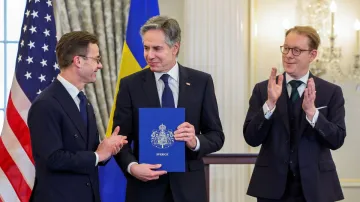Washington: Sweden joined NATO in Washington on Thursday, two years after Russia's invasion of Ukraine forced it to rethink its national security policy and conclude that support for the alliance was the Scandinavian nation's best guarantee of safety. Swedish Prime Minister Ulf Kristersson handed over the final documentation to the US government on Thursday, the last step in a drawn-out process to secure the backing of all members to join the military alliance.
"Good things come to those who wait," U.S. Secretary of State Antony Blinken said as he received Sweden's accession documents from Kristersson. Blinken said “everything changed” after Russia’s full-scale invasion of Ukraine, citing polls showing a massive shift in Swedish public opinion on joining NATO. "Swedes realized something very profound: that if Putin was willing to try to erase one neighbour from the map, then he might well not stop there."
CREDIT: AP
Why did Sweden join NATO?
For NATO, the accessions of Sweden and Finland - which share a 1,340 km border with Russia - are the most significant additions in decades. It is also a blow for Russian President Vladimir Putin who has sought to prevent any further strengthening of the alliance. "Today is a truly historic day. Sweden is now a member of NATO," Kristersson said. "We will defend freedom together with the countries closest to us – both in terms of geography, culture and values."
Sweden will benefit from the alliance's common defence guarantee under which an attack on one member is regarded as an attack on all. Hakan Yucel, 54, an IT worker in the Swedish capital said of the accession: "Before, we were outside and felt a little bit alone ... I think that the threat from Russia, it's going to be much less now."
The Nordic country would add cutting-edge submarines and a sizable fleet of domestically produced Gripen fighter jets to NATO forces and be a crucial link between the Atlantic and Baltic. Russia has threatened to take unspecified "political and military-technical counter-measures" in response to Sweden's move. "Joining NATO is really like buying insurance, at least as long as the United States is actually willing to be the insurance provider," said Barbara Kunz, a researcher at defence think tank SIPRI.
Why did Sweden abandon its neutrality stance post-World War II
While Stockholm has been drawing ever closer to NATO over the last two decades, membership marks a clear break with the past, when for more than 200 years, Sweden avoided military alliances and adopted a neutral stance in times of war.
After World War Two, it built an international reputation as a champion of human rights, and since the Soviet Union collapsed in 1991, successive governments have pared back military spending. As recently as 2021, its defence minister had rejected NATO membership, only for the then-Social Democrat government to apply, alongside neighbour Finland, just a few months later. "I guess [Sweden] had to take a stance really and I'm happy that we actually did and that we are safeguarded by NATO, because the tension with Russia has been growing for a couple of years," said Carl Fredrik Aspegren, 28, a student in Stockholm.
While Finland joined the alliance last year, Sweden was kept waiting as Turkey and Hungary, which both have cordial relations with Russia, delayed ratifying Sweden's accession. Turkey approved Sweden's application in January. Hungary delayed its decision on Sweden's accession until Kristersson made a goodwill visit to Budapest on Feb. 23, where the two countries agreed on a fighter jet deal.
(With inputs from agency)
Also Read: No plans to send troops to Ukraine: NATO as Russia warns of wider confrontation
Latest World News
